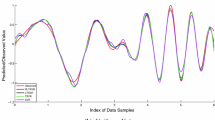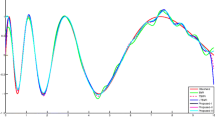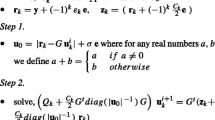Abstract
In this paper, a simple and linearly convergent Lagrangian support vector machine algorithm for the dual of the twin support vector regression (TSVR) is proposed. Though at the outset the algorithm requires inverse of matrices, it has been shown that they would be obtained by performing matrix subtraction of the identity matrix by a scalar multiple of inverse of a positive semi-definite matrix that arises in the original formulation of TSVR. The algorithm can be easily implemented and does not need any optimization packages. To demonstrate its effectiveness, experiments were performed on well-known synthetic and real-world datasets. Similar or better generalization performance of the proposed method in less training time in comparison with the standard and twin support vector regression methods clearly exhibits its suitability and applicability.


Similar content being viewed by others
References
Balasundaram S, Kapil (2010) On Lagrangian support vector regression. Exp Syst Appl 37:8784–8792
Balasundaram S, Kapil (2010) Application of Lagrangian twin support vector machines for classification. In: 2nd international conference on machine learning and computing, ICMLC2010, IEEE Press, pp 193–197
Box GEP, Jenkins GM (1976) Time series analysis: forecasting and control. Holden-Day, San Francisco
Brown MPS, Grundy WN, Lin D et al (2000) Knowledge-based analysis of microarray gene expression data using support vector machine. Proc Nat Acad Sci USA 97(1):262–267
Chen X, Yang J, Liang J, Ye Q (2011) Smooth twin support vector regression. Neural Comput Appl. doi:10.1007/s00521-010-0454-9
Cristianini N, Shawe-Taylor J (2000) An introduction to support vector machines and other kernel based learning method. Cambridge University Press, Cambridge
DELVE (2005) Data for evaluating learning in valid experiments. http://www.cs.toronto.edu/~delve/data
Jayadeva, Khemchandani R, Chandra S (2007) Twin support vector machines for pattern classification. IEEE Trans Patt Anal Mach Intell 29(5):905–910
Joachims T, Ndellec C, Rouveriol (1998) Text categorization with support vector machines: learning with many relevant features. In: European conference on machine learning no. 10, Chemnitz, Germany, pp 137–142
Kumar MA, Gopal M (2009) Least squares twin support vector machines for pattern classification. Expert Syst Appl 36:7535–7543
Li G, Wen C, Guang G-B, Chen Y (2011) Error tolerance based support vector machine for regression. Neurocomputing 74(5):771–782
Mangasarian OL (1994) Nonlinear programming. SIAM Philadelphia, PA
Mangasarian OL, Musicant DR (2001) Lagrangian support vector machines. J Mach Learn Res 1:161–177
Mangasarian OL, Solodov MV (1993) Nonlinear complementarity as unconstrained and constrained minimization. Math Program B 62:277–297
Mangasarian OL, Wild EW (2006) Multisurface proximal support vector classification via generalized eigenvalues. IEEE Trans Patt Anal Mach Intell 28(1):69–74
Mukherjee S, Osuna E, Girosi F (1997) Nonlinear prediction of chaotic time series using support vector machines. In: NNSP’97: Neural networks for signal processing VII: Proceedings of IEEE signal processing society workshop, Amelia Island, FL, USA, pp 511–520
Muller KR, Smola AJ, Ratsch G, Schölkopf B, Kohlmorgen J (1999) Using support vector machines for time series prediction. In: Schölkopf B, Burges CJC, Smola AJ (eds) Advances in Kernel methods- support vector learning. MIT Press, Cambridge, pp 243–254
Murphy PM, Aha DW (1992) UCI repository of machine learning databases. University of California, Irvine. http://www.ics.uci.edu/~mlearn
Osuna E, Freund R, Girosi F (1997) Training support vector machines: an application to face detection. In: Proceedings of computer vision and pattern recognition, pp 130–136
Peng X (2010) TSVR: an efficient twin support vector machine for regression. Neural Netw 23(3):365–372
Ribeiro B (2002) Kernelized based functions with Minkovsky’s norm for SVM regression. In: Proceedings of the international joint conference on neural networks, 2002, IEEE press, pp 2198–2203
Shao Y-H, Zhang C-H, Wang X-B, Deng N-Y (2011) Improvements on twin support vector machines. IEEE Trans Neural Netw 22(6):962–968
The MOSEK optimization tools (2008) Version 5.0, Denmark. http://www.mosek.com
Vapnik VN (2000) The nature of statistical learning theory, 2nd edn. Springer, New York
Zhong P, Xu Y, Zhao Y (2011) Training twin support vector regression via linear programming. Neural Comput Appl. doi:10.1007/s00521-011-0526-6
Acknowledgments
The authors are extremely thankful to the learned referees for their critical and constructive comments that greatly improved the earlier version of the paper. Mr. Tanveer acknowledges the financial support given as scholarship by Council of Scientific and Industrial Research, India.
Author information
Authors and Affiliations
Corresponding author
Rights and permissions
About this article
Cite this article
Balasundaram, S., Tanveer, M. On Lagrangian twin support vector regression. Neural Comput & Applic 22 (Suppl 1), 257–267 (2013). https://doi.org/10.1007/s00521-012-0971-9
Received:
Accepted:
Published:
Issue Date:
DOI: https://doi.org/10.1007/s00521-012-0971-9




